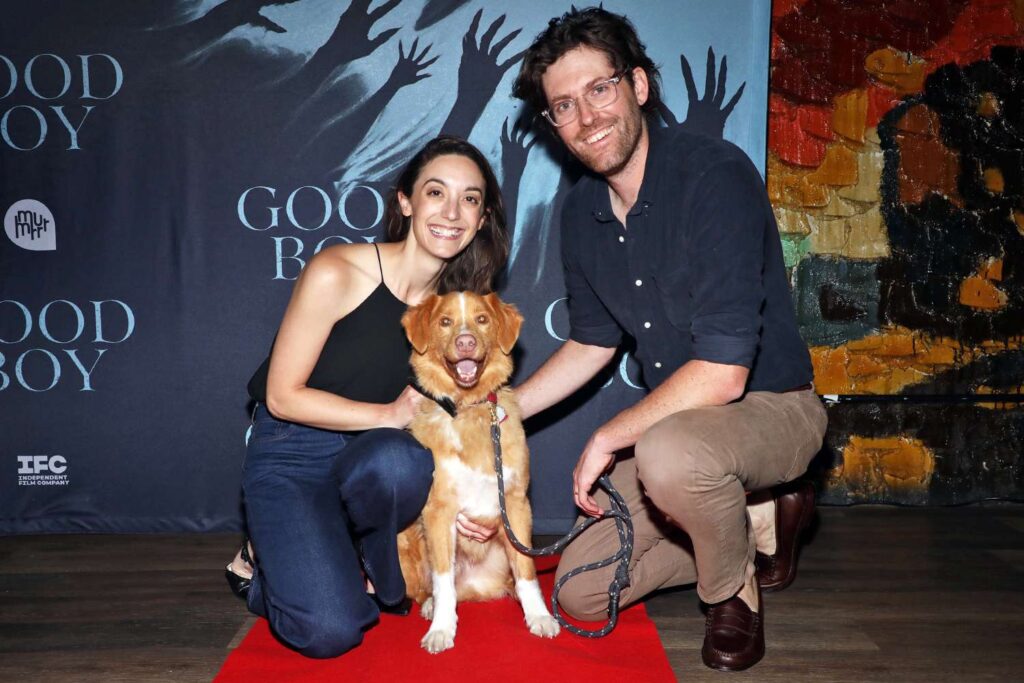NEED TO KNOW
Taylor Swift and Dwayne Johnson may have movies in theaters this weekend, but one dog hopes to give them a run for their money.
Indy, a middle-aged retriever, was cast as the lead in the new horror movie Good Boy by his ‘dog parents,’ director Ben Leonberg and producer Kari Fischer. Does that make him a nepo puppy? Maybe. But Indy commands the screen and earns his spot as a leader of the 2025 spooky season.
Leonberg and Fischer painstakingly filmed Good Boy with their pet over the course of three years, resulting in a unique approach to the haunted-house movie: told entirely from a dog’s perspective.
“I would love for people to see the movie on the big screen the way it’s meant to be seen,” Leonberg says inside PEOPLE’s New York City offices on Wednesday, Oct. 1, with wife Fischer and Indy on one of their various press visits. “He’s a small dog but he looks enormous plastered across a hundred-foot movie screen. We hope people check it out.”
Read on for more about Indy and Good Boy, which is now in theaters everywhere.
IFC/Shudder
PEOPLE: Good Boy premiered at the SXSW Film & TV Festival in March. What was it like seeing it with an audience for the first time?
BEN LEONBERG: Awesome. We spent years making this movie. We believed in the idea, and we definitely want it to be scary. So it was super satisfying to actually hear people gasping and screaming in the right place, and also responding to Indy, which happened pretty immediately.
KARI FISCHER: Yeah, it’s pretty amazing when the first shot of the film comes up and people immediately go, “Awe.”
When did you know that Indy could do this?
LEONBERG: It was a decision we arrived at pretty slowly. I started writing the idea with my co-writer, Alex Cannon, back in 2017. We got Indy that year not with the intention that he would be in the movie or be in any movie. We got him to be our friend and that’s really it. But as we started figuring out how to write the movie, I started making little test short films in our backyard or in our apartment that starred Indy, because he was our dog and he was available. And when he started getting nominated for acting awards, that kind of forced our hand, and we found this very novel way to work with him that resulted in the performance you see in the movie.
Where do you store all of his awards and trophies?
LEONBERG: Well, so far it’s just a few acting nominations and a special Howl of Fame award that he got at South by Southwest. I mean, he doesn’t know he got an award any more than he understands he was acting in a movie. So it won’t go to his head!
IFC/Shudder
Is he aware of any of the extra attention or filming?
LEONBERG: Certainly not the attention. He loves meeting people and he likes being in new places and smelling around a room.
FISCHER: Probably, I don’t know, by the second or third year of filming, he grew to know what the camera meant or that the camera meant that he should do something. It got to the point where he was so excited because he loves having a job. I think he really liked the daily stimulus of it. It got to the point where if we were shooting a shot that didn’t have him in it, we had to close the door because he would come walk in and ruin the shot.
LEONBERG: Yeah, “I’m supposed to be doing something right now, aren’t I?” He knew what the camera was the same way some dogs know what their leash is, that if they see their leash they want to go for a walk. He doesn’t know what the camera does, but he knew it meant time to figure something out. He loves having a job.
Is he sad now that cameras aren’t rolling at home anymore?
LEONBERG: No. I mean, now he just has more time for fetches and walks and napping. I think maybe his true favorite pastime is napping.
IFC/Shudder
When you wanted him to emote certain ways for certain scenes, how did you tell him? As the director, how did you communicate, “You have to be scared right now”?
LEONBERG: The truth is that so much of Indy’s performance doesn’t come from Indy — it comes from the audience and the filmmaking. People are always asking, “How did you get him to look scared?” And the truth is, we didn’t do anything. It’s the filmmaking telling you, “This is a scary movie.” He’s just emoting a neutral expression. But because of shot/reverse shot where we see a dog and then see what the dog sees, and it’s a spooky corner or a moving shadow, the audience does the math of “that’s scary, the dog must be scared.” The dog’s not anything. You’re scared and we, the audience, are projecting our emotions onto him.
So it’s kind of an interesting observation about how performance can work. I think I look at actors different now after this. Some of the best performances don’t do a lot, and we, the audience, bring what we know about the actor and the character and ourselves and our own lives to the movie, which is kind of interesting.
Andy Kropa
FISCHER: We were going back through our behind-the-scenes footage, and there’s one scene in the film in which he looks particularly scared. He’s underneath Todd’s arm. I was listening to the footage. There are moments where he looks to the audience like he’s scared and kind of moving his head. In the footage I’m sitting there with a very squeaky voice saying, “Chicken, pheasant.”
LEONBERG: He’s just reacting because we’re saying things to him that don’t make any sense, but we’re saying it like it’s a command. The same way you could say “sit, stay.” But if you say, “neon sign,” you get these little moments that when you replace all the audio, you add the music and you edit it just so, it looks like a performance. I cannot say enough he does not know he’s in a movie, and that was a big challenge.
After this process, do you think there should be more awards categories for people who work with animals or get them to accomplish certain performances onscreen?
LEONBERG: I mean, any excuse to have Indy wear a bow tie, we’re all there for that! He looks great on a red carpet, looks very dashing in his little black bow tie. I think it’s a part of filmmaking that it’s not dissimilar in some ways almost to puppetry. Like, the puppet doesn’t know it’s in a movie, you’re using shots and blocking and these very basic gestures to convey a performance that resonates with human emotions. So I don’t know how you would lump those things together, but as I say, Indy loves a red carpet.
The trailer — which PEOPLE exclusively debuted in August — went viral online, and Google searches for “does the dog die in Good Boy” reportedly surged. Was that ever in your plan or screenplay, or did you know that’s a cardinal sin of movies?
LEONBERG: We’re certainly aware of how people react and feel about dogs as audiences. I think the fact that people are so invested in the answer hopefully proves their interest in the film, and we were always sure of how the ending was going to go. I think playing with those expectations was kind of part of the idea. Part of the reason so many people googled that is that horror films in particular have kind of trained audiences to be worried, just because dogs frequently are featured in the first act of a horror movie, barking at nothing, staring into empty corners. In a lot of films, the dog doesn’t make it out of act one. So there’s a trope that we’re playing with that we obviously expand into a full three-act structure.
I know it’s very different, but a lot of people are calling Good Boy a live-action Courage the Cowardly Dog. Did that cartoon series inspire you at all? Are you a fan of that?
LEONBERG: I had not thought of it while we were making the movie, that it was in the DNA of the story, but it’s definitely a show I loved as a kid. I’m really happy that many people are remembering and talking about Courage the Cowardly Dog because it really was one of those early-2000s, kind of very troubling animation styles. It felt genuinely scary. So I’m glad it’s resonating.
You spent so much hard work on this movie. What does it mean to now always have this moment in your lives captured on film in this way?
LEONBERG: The movie is, I think in a large sense, a tribute to dogs and it’s about our relationship with dogs. Specifically to us it’s a tribute to our own dog. It’s an amazing time capsule. It captures a very specific part of our life where we kind of really transformed our lives to make this film. The house you see in the movie was our actual house, Indy lived there, so we would get a genuine performance. We appear in the film as the bodies of the main characters, so Indy would be acting with us. It’s a very special and very odd family project.
FISCHER: It’s really lovely. Part of the fun of all of this is we’re obsessed with our dog, and it seems that much of the world is as well, and that’s wonderfully validating and perhaps a tad enabling too! But very fun.
You’re debuting the same weekend in theaters as Taylor Swift’s The Life of a Showgirl Release Party and Dwayne Johnson’s The Smashing Machine. How are you feeling about the competition?
LEONBERG: On opening weekend we’re up against The Rock and Taylor Swift, but I’m sure Indy can hold his own against them. No matter how it turns out, he’ll be getting lots of extra treats and tennis balls this weekend!

